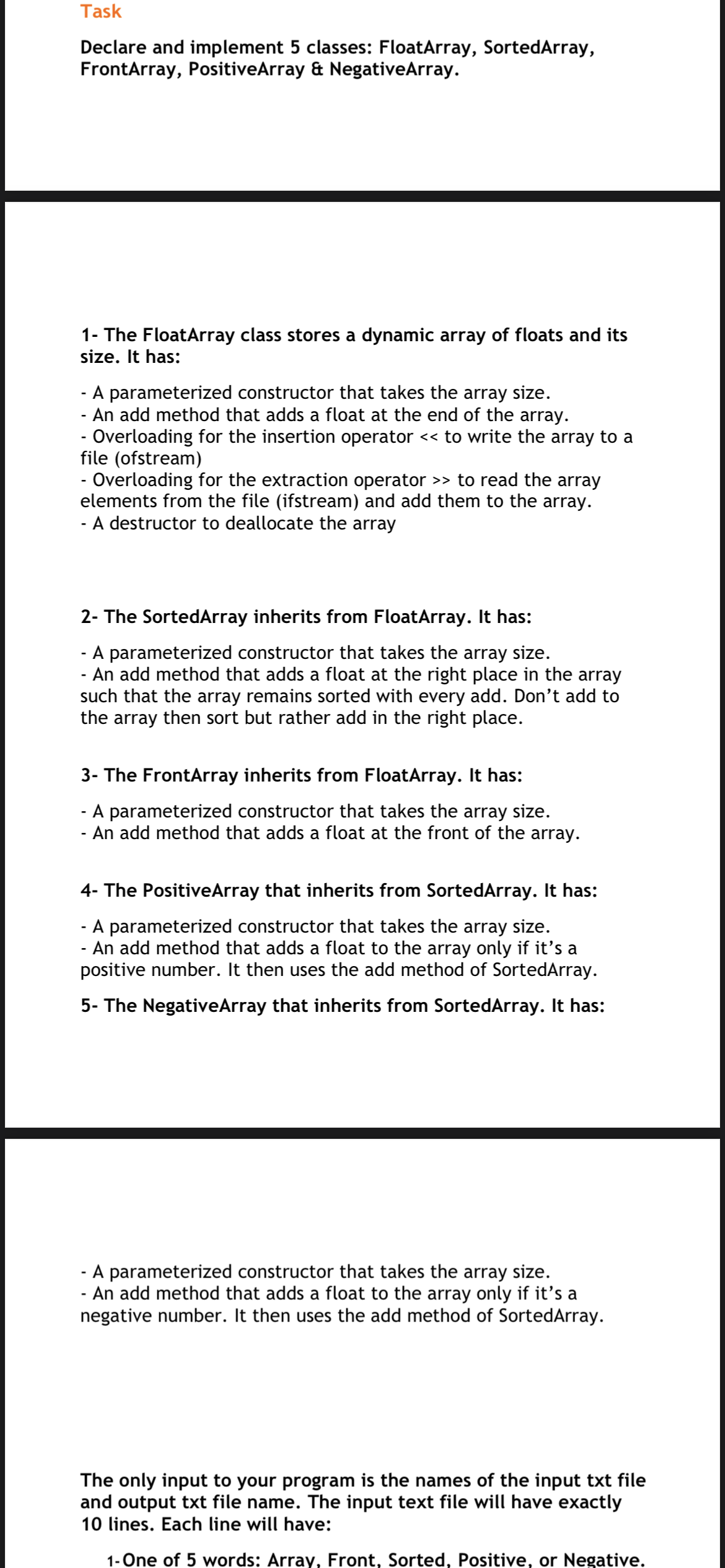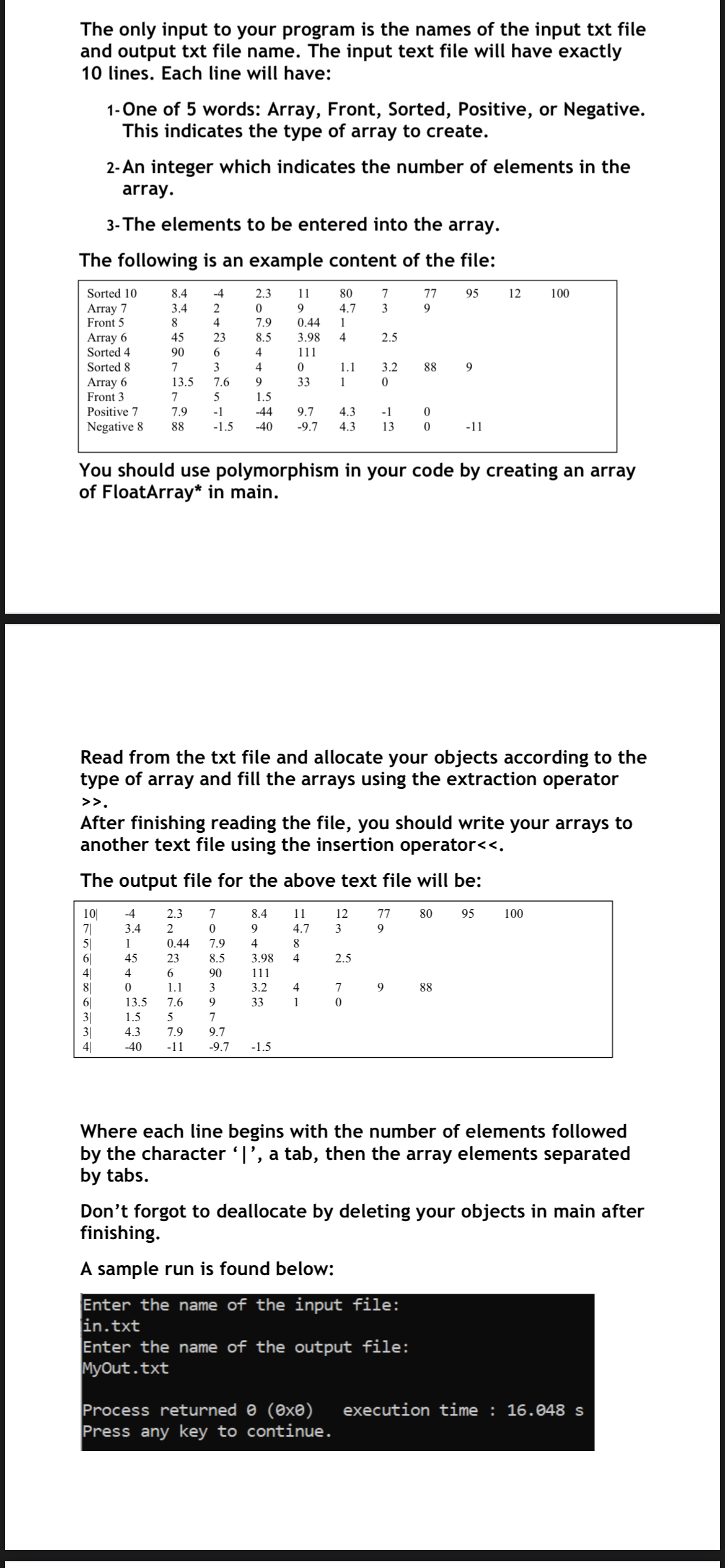Task Declare and implement 5 classes: FloatArray, SortedArray, FrontArray, PositiveArray & NegativeArray. 1- The FloatArray class stores a dynamic array of floats and its size. It has: - A parameterized constructor that takes the array size. - An add method that adds a float at the end of the array. - Overloading for the insertion operator << to write the array to a file (ofstream) - Overloading for the extraction operator >> to read the array elements from the file (ifstream) and add them to the array. - A destructor to deallocate the array 2- The SortedArray inherits from FloatArray. It has: - A parameterized constructor that takes the array size. - An add method that adds a float at the right place in the array such that the array remains sorted with every add. Don't add to the array then sort but rather add in the right place. 3- The FrontArray inherits from FloatArray. It has: - A parameterized constructor that takes the array size. An add method that adds a float at the front of the array. 4- The PositiveArray that inherits from SortedArray. It has: - A parameterized constructor that takes the array size. - An add method that adds a float to the array only if it's a positive number. It then uses the add method of SortedArray. 5- The NegativeArray that inherits from SortedArray. It has: - A parameterized constructor that takes the array size. - An add method that adds a float to the array only if it's a negative number. It then uses the add method of SortedArray. The only input to your program is the names of the input txt file and output txt file name. The input text file will have exactly 10 lines. Each line will have: 1-One of 5 words: Array, Front, Sorted, Positive, or Negative.
Task Declare and implement 5 classes: FloatArray, SortedArray, FrontArray, PositiveArray & NegativeArray. 1- The FloatArray class stores a dynamic array of floats and its size. It has: - A parameterized constructor that takes the array size. - An add method that adds a float at the end of the array. - Overloading for the insertion operator << to write the array to a file (ofstream) - Overloading for the extraction operator >> to read the array elements from the file (ifstream) and add them to the array. - A destructor to deallocate the array 2- The SortedArray inherits from FloatArray. It has: - A parameterized constructor that takes the array size. - An add method that adds a float at the right place in the array such that the array remains sorted with every add. Don't add to the array then sort but rather add in the right place. 3- The FrontArray inherits from FloatArray. It has: - A parameterized constructor that takes the array size. An add method that adds a float at the front of the array. 4- The PositiveArray that inherits from SortedArray. It has: - A parameterized constructor that takes the array size. - An add method that adds a float to the array only if it's a positive number. It then uses the add method of SortedArray. 5- The NegativeArray that inherits from SortedArray. It has: - A parameterized constructor that takes the array size. - An add method that adds a float to the array only if it's a negative number. It then uses the add method of SortedArray. The only input to your program is the names of the input txt file and output txt file name. The input text file will have exactly 10 lines. Each line will have: 1-One of 5 words: Array, Front, Sorted, Positive, or Negative.
Computer Networking: A Top-Down Approach (7th Edition)
7th Edition
ISBN:9780133594140
Author:James Kurose, Keith Ross
Publisher:James Kurose, Keith Ross
Chapter1: Computer Networks And The Internet
Section: Chapter Questions
Problem R1RQ: What is the difference between a host and an end system? List several different types of end...
Related questions
Question
Don't use

Transcribed Image Text:Task
Declare and implement 5 classes: FloatArray, SortedArray,
FrontArray, PositiveArray & NegativeArray.
1- The FloatArray class stores a dynamic array of floats and its
size. It has:
A parameterized constructor that takes the array size.
- An add method that adds a float at the end of the array.
- Overloading for the insertion operator << to write the array to a
file (ofstream)
- Overloading for the extraction operator >> to read the array
elements from the file (ifstream) and add them to the array.
- A destructor to deallocate the array
2- The SortedArray inherits from FloatArray. It has:
- A parameterized constructor that takes the array size.
- An add method that adds a float at the right place in the array
such that the array remains sorted with every add. Don't add to
the array then sort but rather add in the right place.
3- The FrontArray inherits from FloatArray. It has:
A parameterized constructor that takes the array size.
An add method that adds a float at the front of the array.
4- The PositiveArray that inherits from SortedArray. It has:
A parameterized constructor that takes the array size.
- An add method that adds a float to the array only if it's a
positive number. It then uses the add method of SortedArray.
5- The NegativeArray that inherits from SortedArray. It has:
- A parameterized constructor that takes the array size.
- An add method that adds a float to the array only if it's a
negative number. It then uses the add method of SortedArray.
The only input to your program is the names of the input txt file
and output txt file name. The input text file will have exactly
10 lines. Each line will have:
1- One of 5 words: Array, Front, Sorted, Positive, or Negative.

Transcribed Image Text:The only input to your program is the names of the input txt file
and output txt file name. The input text file will have exactly
10 lines. Each line will have:
1- One of 5 words: Array, Front, Sorted, Positive, or Negative.
This indicates the type of array to create.
2- An integer which indicates the number of elements in the
array.
3- The elements to be entered into the array.
The following is an example content of the file:
Sorted 10
8.4
-4
2.3
11
80
7
77
95
12
100
Array 7
Front 5
3.4
9
4.7
3
9
8.
4
7.9
0.44
1
Array 6
Sorted 4
45
23
8.5
3.98
4
2.5
90
4
111
Sorted 8
7
4
1.1
3.2
88
Array 6
Front 3
13.5
7.6
9.
33
1
7
1.5
Positive 7
7.9
-1
-44
9.7
4.3
-1
Negative 8
88
-1.5
-40
-9.7
4.3
13
-11
You should use polymorphism in your code by creating an array
of FloatArray* in main.
Read from the txt file and allocate your objects according to the
type of array and fill the arrays using the extraction operator
>>.
After finishing reading the file, you should write your arrays to
another text file using the insertion operator<<.
The output file for the above text file will be:
10|
7|
5|
6|
4|
8|
6|
3|
3|
4|
-4
2.3
7
8.4
11
12
77
80
95
100
3.4
2
9.
4.7
3
1
0.44
7.9
4
8
45
23
8.5
3.98
4
2.5
4
90
111
1.1
3
3.2
4
7
9
88
13.5
7.6
33
1
1.5
5
7
4.3
7.9
9.7
-40
-11
-9.7
-1.5
Where each line begins with the number of elements followed
by the character T', a tab, then the array elements separated
by tabs.
Don't forgot to deallocate by deleting your objects in main after
finishing.
A sample run is found below:
Enter the name of the input file:
in.txt
Enter the name of the output file:
MyOut.txt
Process returned 0 (0xe)
Press any key to continue.
execution time : 16.048 s
Expert Solution
This question has been solved!
Explore an expertly crafted, step-by-step solution for a thorough understanding of key concepts.
Step by step
Solved in 2 steps with 12 images

Recommended textbooks for you

Computer Networking: A Top-Down Approach (7th Edi…
Computer Engineering
ISBN:
9780133594140
Author:
James Kurose, Keith Ross
Publisher:
PEARSON

Computer Organization and Design MIPS Edition, Fi…
Computer Engineering
ISBN:
9780124077263
Author:
David A. Patterson, John L. Hennessy
Publisher:
Elsevier Science

Network+ Guide to Networks (MindTap Course List)
Computer Engineering
ISBN:
9781337569330
Author:
Jill West, Tamara Dean, Jean Andrews
Publisher:
Cengage Learning

Computer Networking: A Top-Down Approach (7th Edi…
Computer Engineering
ISBN:
9780133594140
Author:
James Kurose, Keith Ross
Publisher:
PEARSON

Computer Organization and Design MIPS Edition, Fi…
Computer Engineering
ISBN:
9780124077263
Author:
David A. Patterson, John L. Hennessy
Publisher:
Elsevier Science

Network+ Guide to Networks (MindTap Course List)
Computer Engineering
ISBN:
9781337569330
Author:
Jill West, Tamara Dean, Jean Andrews
Publisher:
Cengage Learning

Concepts of Database Management
Computer Engineering
ISBN:
9781337093422
Author:
Joy L. Starks, Philip J. Pratt, Mary Z. Last
Publisher:
Cengage Learning

Prelude to Programming
Computer Engineering
ISBN:
9780133750423
Author:
VENIT, Stewart
Publisher:
Pearson Education

Sc Business Data Communications and Networking, T…
Computer Engineering
ISBN:
9781119368830
Author:
FITZGERALD
Publisher:
WILEY